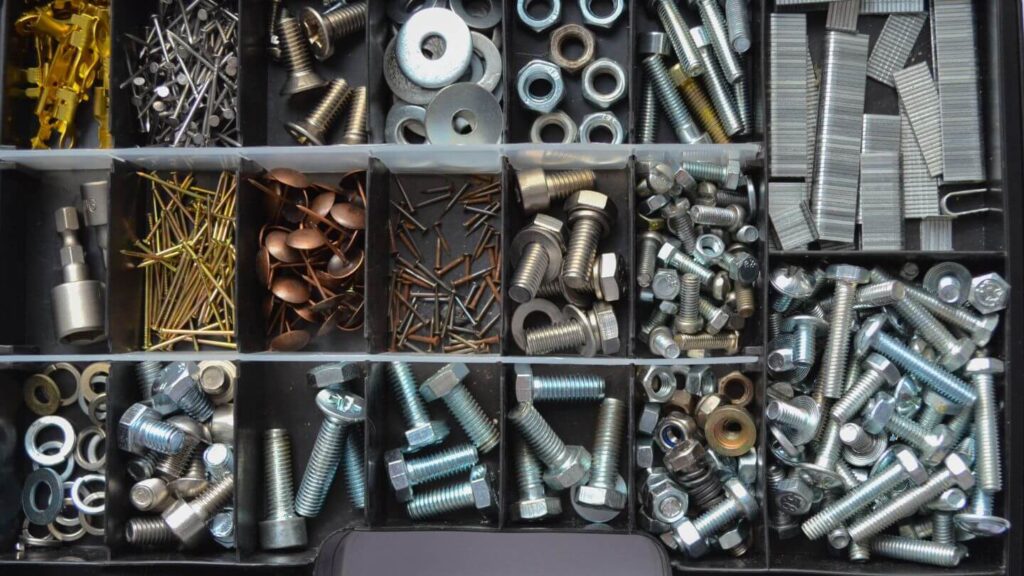What Is MRO Inventory and How to Manage It?
MRO (Maintenance, Repair, and Operations) inventory is comprised of items that support the manufacturing process but are not directly tracked as part of any bill of materials. Nevertheless, MRO inventory should be managed diligently in order to avoid work stoppages and late deliveries.

You can also listen to this article:
What is MRO inventory?
MRO (Maintenance, Repair, and Operations) inventory encompasses a diverse range of items crucial for manufacturing operations, including spare parts, consumables, safety equipment, cleaning supplies, office supplies, and personal protective equipment (PPE), among others.
Unlike raw materials used directly in production, MRO items indirectly support the production process by ensuring safety and maintaining machinery, facilities, and the overall work environment. Effective MRO inventory management is therefore crucial for avoiding costly disruptions related to MRO stockouts.
Examples of MRO inventory
Spare parts
Spare parts are essential components kept on hand to replace faulty or worn-out machinery parts promptly. These items are critical for minimizing downtime and ensuring uninterrupted production. Examples of spare parts include drill bits, bearings for machinery, pumps for fluid handling, belts for conveyor systems, and motors for production equipment.
Consumables
Consumables are items that are used up during the manufacturing process and need regular replenishment. These items include fasteners such as bolts and screws, lubricants for machinery maintenance, adhesives for assembly processes, and filters for air and water purification systems.
Personal protective equipment (PPE)
PPE is crucial for protecting workers from hazards in the workplace. Examples of this safety equipment include hard hats for head protection, respiratory masks, protective clothing, gloves, and safety glasses.
Cleaning supplies
Cleaning supplies are necessary for maintaining a clean and hygienic work environment. These items include detergents for general cleaning, disinfectants for sanitization, and cleaning tools such as mops and sponges.
Office supplies
Office supplies are essential for administrative tasks within a manufacturing facility. Examples include paper for printing documents, pens for writing, and printer cartridges for printing labels and documentation.
Facility maintenance items
Facility maintenance items are essential for keeping the manufacturing facility in optimal working condition. Examples include light bulbs, batteries, safety signage, and HVAC filters.
Fluids and chemicals
Fluids and chemicals are necessary for various manufacturing processes, such as cooling, lubrication, and cleaning. Examples include coolants for machinery cooling, solvents for cleaning parts, and lubricants and hydraulic fluids for equipment operation.
Packaging materials
Manufacturers often also designate packaging materials such as cardboard boxes, pallets, cling film, etc. as MRO. Product packaging, however, could alternatively be included in the BOM of the product.
Why is MRO inventory management important?
Effective MRO inventory management is crucial for the smooth operation and profitability of businesses, particularly in the manufacturing sector. Here’s why it’s so important:
- Preventing downtime. Proper management ensures that necessary MRO items are always available, reducing the risk of stockouts that could halt production lines and cause costly downtime.
- Optimizing procurement. Efficient MRO inventory management involves strategic procurement practices, such as forecasting demand, reducing lead times, and establishing optimal inventory levels, which can minimize costs and streamline the supply chain.
- Reducing inventory costs. By controlling stock levels and avoiding overstocking, businesses can minimize inventory costs associated with storage, handling, and obsolescence, positively impacting the bottom line.
- Supporting production processes. MRO items directly support the production process by maintaining machinery and facilities, ensuring smooth operations and maximizing productivity on production lines.
- Increasing profitability. Effective management of MRO supplies contributes to overall profitability by reducing the risk of costly breakdowns, optimizing maintenance schedules, and minimizing unnecessary expenditures.
- Tailoring to small businesses. Small businesses, in particular, can benefit from streamlined MRO inventory management practices, as they often have limited resources and storage space, making efficient use of inventory crucial for success.
- Facilitating maintenance management. MRO inventory management facilitates preventive maintenance activities by ensuring the availability of necessary supplies and optimizing storage space for maintenance-related items.
In summary, effective MRO inventory management is essential for minimizing downtime, controlling costs, supporting production processes, and ultimately increasing profitability, making it a critical aspect of business operations in the manufacturing industry.
8 steps of effective MRO inventory management
The basic steps of MRO inventory management typically include:
- Identify your MRO items. Define as MRO the items that are used in the manufacturing process (including in auxiliary administrative processes) but are not part of any bill of materials. Categorize the items based on their usage, criticality, and impact on operations and maintenance activities.
- Forecast demand. Demand forecasting for MRO items should be based on historical usage data, maintenance and production schedules, and anticipated needs.
- Plan for replenishments. Although MRO is rarely continuously tracked, you can still plan for replenishments. In environments with consistent demand, you can determine the optimal interval for reordering, e.g. every 60 days. In job shops and other environments with inconsistent demand, you can set reorder points for your MRO items and periodically check whether their inventory levels have fallen below the ROP manually.
- Establish safety stock levels. Determine optimal safety stock levels for critical MRO items to mitigate the risk of stockouts.
- Establish supplier relationships and a defined procurement process. Establish relationships with reliable suppliers or distributors for MRO items and negotiate favorable pricing and terms to support efficient procurement. Develop streamlined procurement processes for acquiring MRO items, including the generation of purchase orders, supplier communication, and receipt of goods.
- Physically organize your MRO inventory. Designate appropriate storage areas within the facility for MRO items, ensuring accessibility, organization, and proper labeling for easy identification.
- Track and manage inventory. Implement inventory tracking mechanisms, such as barcode systems or inventory management software, to monitor and manage the procurement of MRO items as non-inventory items.
- Regularly review and adjust. Conduct regular reviews of MRO inventory levels, usage patterns, and procurement processes to identify areas for improvement and adjust MRO inventory management strategies accordingly.
By following these basic steps, organizations can establish effective MRO inventory management practices to support maintenance activities, minimize downtime, and ensure the smooth operation of machinery and facilities.
KPIs related to MRO inventory
Although raw materials and finished goods inventory should take first priority at any manufacturing company, manufacturers should still track some key performance indicators related to MRO inventory to assess performance and identify areas for improvement. Here are some MRO-related inventory management KPIs:
- Stockout rate. Percentage of time that critical MRO items are unavailable when needed, indicating the effectiveness of inventory management in preventing stockouts and minimizing downtime.
- Inventory turnover. The inventory turnover ratio reflects the number of times MRO inventory is replenished or used within a specific period, reflecting the efficiency of inventory management processes in minimizing excess inventory and optimizing resource utilization.
- Carrying costs. Total costs associated with holding and managing MRO inventory, including storage, handling, and obsolescence costs, indicating the efficiency of inventory management in minimizing unnecessary expenses.
- Supplier performance. Supplier performance includes metrics such as on-time delivery, lead time variability, and quality of MRO items received from suppliers, assessing supplier reliability and the impact on inventory management processes.
- Accuracy of demand forecasting. This KPI shows the discrepancy between forecasted and actual demand for MRO items, assessing the accuracy of demand forecasting methods and identifying opportunities for improvement.
By tracking these MRO-related KPIs, manufacturers can gain insights into the effectiveness of their inventory management processes, identify areas for optimization, and make informed decisions to improve operational efficiency and minimize costs.
MRO management with inventory management software
Managing MRO inventory with inventory management software such as an ERP or MRP software can significantly increase MRO inventory tracking and control efficiency. Here’s how it works:
- Clear classification. Properly classify MRO items as non-inventory items within the inventory management software to distinguish them from other inventory categories. This classification ensures that MRO items are not tracked as part of regular inventory but are still accounted for in procurement and invoicing processes.
- Streamlined procurement. Utilize the software’s functionality to create purchase orders for MRO items as non-inventory items. This allows for streamlined procurement processes while ensuring that necessary MRO supplies are acquired in a timely manner.
- Cost tracking and management. Take advantage of the software’s capabilities to track costs associated with MRO items, including purchases, expenses, and vendor payments. This enables accurate cost analysis and management, contributing to overall financial visibility and control.
- Integration with manufacturing. MRP software integrates inventory management software with production planning to synchronize data and ensure seamless communication between different business processes, such as procurement, finance, and operations.
- Real-time reporting and metrics. Leverage the software’s reporting and analytics tools to monitor key metrics and KPIs related to MRO inventory management, such as procurement lead times, vendor performance, and spending trends.
- Vendor-managed inventory (VMI) collaboration. Collaborate with suppliers to implement VMI programs for MRO items through the inventory management software. Suppliers can monitor MRO inventory levels and replenish stock as needed, reducing administrative burden and ensuring timely supply.
By effectively leveraging inventory management software and designating MRO items as non-inventory items, manufacturers can streamline procurement processes, track costs accurately, and ensure the availability of essential supplies for maintenance activities without the complexities of traditional inventory management.
Key takeaways
- MRO (Maintenance, Repair, and Operations) inventory includes a diverse range of items essential for manufacturing operations, such as spare parts, consumables, safety equipment, cleaning supplies, and office supplies.
- Effective MRO inventory management is crucial for preventing downtime, optimizing procurement, reducing inventory costs, supporting production processes, and increasing profitability.
- The basic steps of MRO management include identifying MRO items, forecasting demand, planning for replenishments, establishing safety stock levels, managing suppliers and procurement processes, organizing inventory storage, tracking inventory, and regularly reviewing and adjusting inventory management strategies.
- Key performance indicators related to MRO inventory include stockout rate, inventory turnover, carrying costs, supplier performance, and accuracy of demand forecasting, which provide insights into inventory management effectiveness and areas for improvement.
- Utilizing inventory management software, such as ERP or MRP software, enables efficient tracking and control of MRO inventory by providing clear classification of non-inventory items, streamlining procurement processes, tracking costs, integrating with manufacturing processes, and facilitating real-time reporting and collaboration with suppliers.
Frequently asked questions
MRO stands for Maintenance, Repair, and Operations.
Small businesses can effectively manage their MRO inventory by prioritizing critical items, utilizing efficient procurement practices, optimizing storage space, and leveraging inventory management software tailored to their needs.
To determine reorder points and safety stocks for MRO items in manual tracking scenarios, businesses can analyze historical usage patterns, consider lead times for procurement, assess the criticality of items, and establish buffer stock levels based on risk tolerance and demand variability.
You may also like: Raw Material Inventory Management Guide for SMEs




